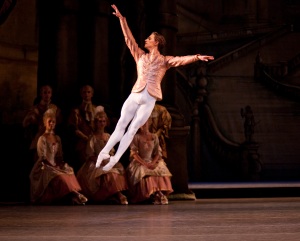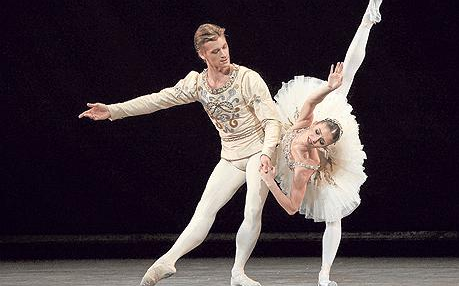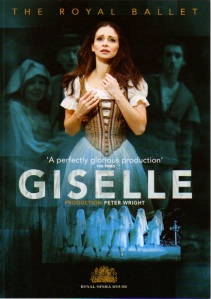Balanchine‘s first full-length abstract ballet is a celebration of styles and his tribute to the tradition that had shaped ballet during the 19th and 20th centuries. One can only marvel at his achievement while admiring the complexity of the choreography, the richness of the steps and the inclusion of novelty movement and geometry between the dancers. Jewels is a crowd pleasing ballet that will always touch us in a particular way, even more if it is danced with complete command of both technique and artistry.
The programme notes alert us to the natural associations one may draw between the ballet’s name and “a formal kaleidoscope”. When first approaching Jewels, it might seem that this is the case: the designs, costumes and music are all beautiful in every sense of the word, one can only stare in disbelief when the curtain opens to reveal the dancers in Emeralds. Never having seen it live before, I came to the opening performance with two missions: first to see how would I react to each different ballet and second to try to understand how Rubies became more popular on its own than Diamonds or Emeralds.
On the first account, it surprised me to discover that although Balanchine is a master of the abstract, with a firm purpose to make us “see the music”, the possibilities of adding personal layers of interpretation to this ballet are endless. I found myself building a story for every single piece, creating characters out of the dancers’ portrayals (I wished I could query the dancers as to their particular ideas and stories when learning the choreography). I also realised, after a second view, that these “stories” changed with every cast, and depended on how they personally approached their roles, who they were partnering, the chemistry, how they presented themselves, physical proportions, etc. In some ways, an abstract ballet gives more interpretive freedom to the dancers while the audience has an opportunity to draw their own impressions from the proverbial “put a man and a woman together and you get a story”.
Emeralds
The first night Emeralds brought us Tamara Rojo in the role that Violette Verdy made famous. She was partnered by Valeri Hristov replacing the “irreplaceable” (and sadly injured) Edward Watson, whom we missed deeply, since Tamara did not seem to have the same level of complicity with Valeri as she has with Edward. Tamara made use of her expressive arms and amazing acting ability to show us a young girl in love: smiley, flirty and sometimes shy, evading the looks of her suitor, running between the other Emerald ladies. Valeri was the man in love trying to conquer the object of his affection while Tamara tip-toed and twirled through her variation like a maiden who daydreams of her knight in a meadow full of flowers with a stream nearby, with added touches of butterflies and songbirds for good measure. All innocence and young love. Pure joy. Hristov’s variation was ably performed, though less eloquent in Romantic imagery: up to that point, it was all about Tamara.

Leanne Benjamin in Emeralds. Photo: Johan Persson. Source: Danceviewtimes
That is, until Leanne Benjamin appeared on stage. It is quite hard for anyone to steal Tamara’s thunder, but we feel that Leanne achieved this in the way she wove so much drama into the Emeralds “Walking pas de deux“. Here was a mature dancer on top of her game, giving us darkness after the sun, like an older woman saying to the world – here I am, I am still beautiful, still full of things to give, just look at me! – Piqué turns and grand battements made her vaporous tutu ethereal, and even though the movements were strong there was a sense of underlying sadness. This interpretation came full circle when a moody looking Bennet Gartside (replacing an injured Ivan Putrov) brought into the same pas de deux the feel of a mature married couple, struggling with the realisation that time is passing them by, that they are not what they used to be (suggested by the emphasis on arms and legs as clock hands). Registering every nuance of her interpretation I couldn’t stop wondering why Leanne is not as popular as some of the other Royal Ballet younger ballerinas.
The Emeralds pas de trois was danced by the fantastic trio of Steven McRae, Deirdre Chapman (back from maternity leave) and Laura Morera, in what it looked to me like the “hot young guy” surrounded by two enamoured girls. Their execution was flawless and of course, Steven made ample use of this opportunity to show off his fantastic split jetés and perfect tours en l’air.
The second cast of Emeralds had Roberta Marquez and Mara Galeazzi partnered by each of Valeri Hristov (in the same role as opening night) and David Makhateli. These interpretations were a complete constrast to Tamara and Leanne’s rich narratives, with Roberta a more straightforward Emerald who was just enjoying her dancing (and indeed, her smile was infectious). Personally I did not feel Emeralds was a good fit for Mara, since she didn’t convey the innate romanticism in the music and air. As the two leading men were not outstanding, I took the opportunity to observe here some of the girls who are starting to stand-out from the corps (and I wished the ROH included portraits of the artists and first artists in their programmes). The highlight of this performance was the pas de Trois, in which Helen Crawford and Samantha Raine shone, accompanied by an efficient José Martín.

From left to right: Tamara Rojo, Leanne Benjamin, Steven McRae and Roberta Marquez. Source: ROH ©. Copyright belongs to its respective owners.
In both performances, the finale was well executed and the members of the corps looked sharp and well-rehearsed, all the way to the final pose where the three men, in grand reverence, stare at the horizon.
Rubies

The Royal Ballet in Rubies. Photo: Johan Persson ©. Source: Voice of Dance.
Next stop was sizzling, fun and jazzy Rubies, or should I rename it the A&A Show after the main duo of “Alexandra Ansanelli and Carlos Acosta“. For Alexandra owned the role. I wondered whether this was due to her long history with NYCB and Balanchine choreography, combined with the fact that she has been outstanding this season or simply that she is enjoying her very last performances before retirement from dance. She played and flirted with Carlos, swaying effortlessly, charmingly and elegantly through her steps. Carlos kept up the dialogue onstage and answered every single stroke, lest he be outshined by this leading lady. They were like the couple everyone stares at on the dance floor, nothing else seemed to matter for them. Here was an amazing newly discovered chemistry between them, which felt fresher than his own longstanding (and famous) partnership with Tamara. If only Alexandra and Carlos could have been paired up more often, they might have really complemented each other in various ways.
Moving from pas de deux to solo, Carlos and Alexandra showcased their technical abilities while keeping up with the demanding pace, Carlos in particular relishing the opportunity to prove to the audience that he could soar through the stage at least as dazzlingly as Steven McRae from the previous section (plenty of grand jetés and ballon – daring to pause in the air -). Alexandra kept pushing the limits of the choreography, to the point of being in danger of falling. When a missing step called her bluff she just squealed and shrugged it off, which made the performance even more real and endearing.
Less secure was Laura McCulloch in both Rubies casts, covering both Zenaida Yanowsky and Lauren Cuthbertson as the “Tall Girl”. She seemed eager to eat the stage but wobbled through a few of her arabesques and although much calmer (yet equally enthusiastic) on second performance, I ended up with the impression that she lacks some of the agility and speed to launch her ruby off the ground (though her extensions were amazing, particularly on the second night) and to keep up with the frantic pace of the corps. While I give Laura full marks for being able to pull a two-nighter on a main role at short notice & to stand her ground in a starry cast, I suspect her inner jewel is not really a ruby.
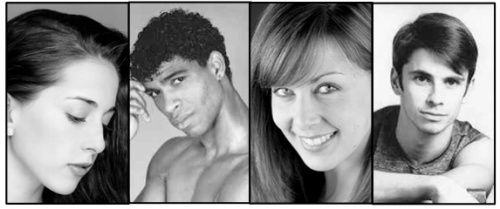
From left to right: Alexandra Ansanelli, Carlos Acosta, Laura McCulloch and Ricardo Cervera. Source: ROH ©. Copyright belongs to its respective owners.
The second cast of Rubies was led by Yuhui Choe (debuting) and Ricardo Cervera. They brought something different than the previous pair, acing the technical demands whilst looking like teenagers fooling around. The casting of Yuhui – a dancer with the softest arms, who looks in my opinion more Emeralds or Diamonds than Broadway – exemplifies the importance of giving dancers the opportunity to explore roles not immediately associated with them, to avoid “typecasting”. Important yes, but not necessarily always a good fit. Ricardo didn’t match Acosta’s performance but showed us again that he can jump like the best of them, and he definitely “popped out” when surrounded by the corps in the finale.
With Rubies over, I finally understood its appeal and own success story. It is such an infectious audience-pleaser, filled with continuous surprises, twists and turns. The choreography is so strikingly different. While Emeralds is a thing of pure beauty, Rubies is the one people cheer for & laugh at. It is box office friendly, and its upbeat, full of spark atmosphere immediately grabs the occasional ballet goers’ attention and takes them along for a wild ride.
Diamonds
The regal Diamonds, the last ballet of the evening, is full of Imperial Russian grandeur and nods to the classics (the hand in the hair from Raymonda, the balances on attitude from Sleeping Beauty‘s Rose Adagio, the arched back on retiré position from Act III Swan Lake, etc). The opening waltz for the corps de ballet immediately reminded me of Sleeping Beauty and Petipa in the beautiful classical lines displayed everywhere and its almost overwhelming grandeur. Still, this serves just as an aperitif to what follows next, the “grand pas de deux.” Opening night saw the beautiful Alina Cojocaru, continuing her comeback from injury, and Rupert Pennefather (who despite being quite tall has been dancing the lead role with tiny Alina since 2007, when he stood in at the premiere for an injured Federico Bonelli) looking picture perfect as prince and princess (again, think Aurora). This opening performance had quite a special “aura” that could be felt in the auditorium, as if we were all collectively gauging how Alina might have changed post her prolonged absence from the stage. She performed carefully and given the difference in height there were also slight complications and miniminal issues in Rupert’s partnering (as on the aided pirouettes). All this didn’t matter since it was more her artistry that shone through her dancing, her arms expressing every single note of the music, her face full of emotion, but with an underlying melodramatic tone that permeated the pas de deux. In some wonderful balances on attitude you could feel her full commitment to the steps, as if there was no tomorrow and this was the last time she could do this. It was not Aurora on stage, or any other of the Petipa heroines, but a more womanly princess, completely aware of her emotions and transparent to everyone to see. Suffice to say that her performance affected me in such a way that I still need some time to think about it.

Alina Cojocaru and Rupert Pennefather in Diamonds. Photo: Tristram Kenton ©. Source: The Guardian.
Rupert was a handsome prince and his dancing was sharp and precise, showing all the dividends he has accumulated this season as a dancer. His variation was elegant and noble. I thought he complimented Alina’s performance in a subdued way, and it was very sweet of him to thank her at the end, as if it had been his privilege to dance with her. He might not be my favourite partner for Alina, but he is definitely a dancer who is getting better and better.
The second cast was led by sunny Marianela Nuñez and her real life prince Thiago Soares. Given the season Marianela has had, it would be difficult to think she wouldn’t ace this role, and indeed she did. As usual, her technique came across strongly and Thiago was more than an accommodating partner (his variation featured slightly different jumps than Rupert’s, but all cleanly executed). However, I couldn’t help feeling as if I was watching a reprisal of the Wedding festivities of Sleeping Beauty. There was not as much depth as in Alina’s and Rupert’s performance, but this might be just my personal take on it, as underneath it all, this is an abstract ballet.
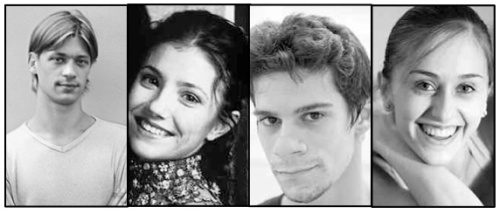
From left to right: Rupert Pennefather, Alina Cojocaru, Thiago Soares and Marianela Nuñez. Source: ROH ©. Copyright belongs to its respective owners.
I should also add honorary mentions to the corps in the polonaise (although they offered a much better and coordinated performance on second night) and to Thomas Whitehead, Yohei Sasaki and Yuhui Choe on the first night, and Brian Maloney, Sergei Polunin, Helen Crawford and Samantha Raine (on double duty together with Emeralds), all of whom noticeably good in their soloist roles.
In short, Diamonds stands as a great closing piece, one that evokes and pays tribute to the classics, while also serving as a rich frame to the central couple and in particular the main ballerina. It is the dance equivalent of a decadent dessert, a celebration of dance which is best enjoyed and appreciated alongside first courses of Emeralds and Rubies. In any case, the Royal Ballet did well to acquire the three ballets for its repertoire. It is the ideal vehicle for showcasing the jewel-like ballerinas in its ranks. I am quite sure I will be going back to Covent Garden anytime it is revived.

Read Full Post »






